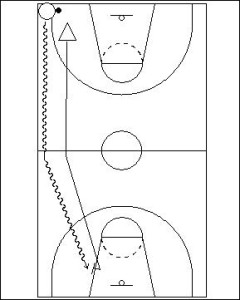1 v 1 Clamping Full Court Drill
The 1 v 1 Clamping Full Court Drill is a fantastic breakdown drill for teaching the one on one principles involved in full court man to man defence. The 1 v 1 Clamping Full Court Drill is useful both as a full court and half court teaching scenario. For many coaches this is will be an invaluable aspect about the drill as not many options are available for competitive drills that bring together so many elements.
The 1 v 1 Clamping Full Court Drill starts with both and offensive and defensive players on the baseline at one end of the court. The players engage in a competitive contest moving from one end of the floor to the other with end of the drill as a result of the defensive player achieving a stop or the offensive player scoring.
Some of the key teaching points for this drill are:
The defensive player starts the drill by handing the ball to the offensive player; the defensive player should look to angle their footwork so the offensive player from the very start is directed towards the sideline. While it is not always possible to direct a ball handler towards the sideline exclusively, the defensive player should always be looking to think about their positioning utilise the sideline as an extra help defender.
The offensive player must look to beat the defensive player at every opportunity; this seems like an obvious statement but sometimes players can be caught up in the practicing of a drill rather than practicing for playing a game. The offensive player must be directed and allowed to beat the defensive player when, and if possible.
In this drill the defensive player must first be aware of their own abilities and limitations before they can explore the possibility of pressuring the ball handler. As a coach if you ask your players to do the opposite by attacking the dribbler initially, they will continue to be beaten within one or two dribbles and take longer to learn how to adapt to their ability and then get the most out of the capabilities.
The defensive player must always maintain and inside lane staying between the dribbler and the basket; if the offensive player achieves inside position it will be difficult for the defensive player to recover and move into a stopping position. Practice makes perfect in this situation, as it is only through a heightened defensive awareness about the space available on the floor, the position of both players on the floor and the goal of playing defence in the teams system that will result in the defence being able to maintain pressure on the dribbler.
Drills like the 1 v 1 Clamping Full Court Drill should be practiced at game pace, not drill pace. Constantly look towards driving players speed in offense harder and harder. A by-product of this offensive pace will be the increased challenge for your defensive players and ultimately your team’s game performance as a whole will improve.
If your offensive players continue to work hard they will develop a capability to handle pressure and still be able to advance the ball. Ensure for the most effective workout that at least initially, your best ball handlers and on-ball defenders are matched up against one another to allow for the greatest opportunity of growth out of offense and defence.

Players start in long corner. The defensive player (inside) maintains distance from the offensive player and forces the player down the sideline.
The defensive player should be positioned diagonally to the ball so if the dribbler tries to move towards the middle of the floor, quick defensive slides can be taken and the middle lane denied.
Once the offensive player reaches the front court the distance between the two players should be reduced by the defender until pressure defence in gained.
Once in front court the defensive player should force the dribbler into short corner and poor shooting options.
Point of Emphasis:
- Game pace
- Players must recover by sprinting
- Defence must carry hands and maintain defensive stance
- Nose of the defender should always be “on the ball”; never too far in front and never behind
Variations:
- The defensive player can be instructed to try and turn the player in the backcourt. A goal of a number of times can be given to try and increase the challenge. For example turn the dribbler three times in the back court.
- Offensive players can have the mount of dribble they are entitled to use limited to increase efficiency and speed of activity. For example start with unlimited dribbles, and then decrease to ten dribbles, etc.





